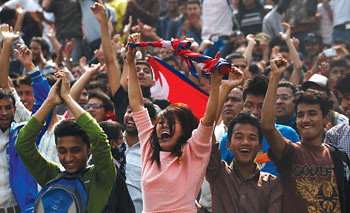Young voters have strength in numbers and can influence politics by electing accountable leaders

BIKRAM RAI
As a sea of red and blue flags fluttered at the TU cricket ground in Kirtipur on Wednesday afternoon, the 20,000 plus spectators gathered to watch their home team in the ACC-T20 finals displayed a rare unity that has often eluded Nepalis.
But it didn’t take long for the euphoria to turn into a familiar sense of frustration and despair. After dominating UAE in the semis, Nepal succumbed to Afghanistan which has become our greatest sporting rival both in cricket and football.
For a country that finds itself in a precarious balance between democracy and extremism as it tries to recover from three decades of conflict, Afghanistan’s meteoric rise in international cricket has surprised many here. Like Nepalis, they too are disillusioned with power hungry, corrupt politicians, but sports there offers a real outlet for many young Afghans.
Nepalis can’t even look to sports for escape. Like rest of our governing system, sports associations are steeped in corruption and their million dollar budgets are lavished on junkets not training. Forget facilities outside Kathmandu, even the Dasrat Stadium is decrepit.
One-third of Nepal’s population is between 15-39 years, but they don’t count in our myopic and self-centred politics. More than 1,000 Nepali youngsters line up at Kathmandu airport every day to escape the drudgery and hopelessness.
While the national literacy rate has gone up to 66 per cent and enrollment in primary schools is at an all time high, female literacy rate is plateauing off. Over half a million 15-16 year olds completed their SLC exams last month, but there aren’t enough jobs for them and not enough colleges for those who want to pursue higher studies. The gap between those who can pay their way into colleges and jobs and those who can’t, widens every day. Youth ‘self-employment’ schemes are just a ploy to fill party coffers.
Cross-tabulated data from the Himalmedia Public Opinion Poll 2013 shows that more than half the respondents in the 18-39 age group feel the country is doing far worse than three to four years ago. When asked which political leader they would want as prime minister, 20 per cent of the cohort said there is no such leader and 15 cent were undecided. Even ‘youth’ leader Gagan Thapa failed to make a mark among the youth.
Although they seem indifferent towards particular parties and leaders, trust in the democratic process is high with 60 per cent of young Nepalis saying free and fair elections are possible. Ethnicity-based federalism was even more unpopular in this age range with 80 per cent thinking it is a bad idea.
While half the respondents in the 25-39 age group said their salary was barely enough, 60 per cent of the same group said they would stay in Nepal and ‘work harder’ for a better future, only 10 per cent wanted to migrate for work. Those looking for jobs abroad were slightly higher at 15 per cent in the 18-24 age bracket.
The youth bulge provides foot soldiers for political parties, militant groups, and the mafia. And as the parties gear up for campaigns for or against elections, there is a risk that they will once again be conscripted as we will no doubt see on Sunday.
Nepal’s youth have to be an integral part of the democratic process. They have strength in numbers and can influence politics by electing accountable leaders with integrity and vision. The two million Nepalis who turned 18 since 2008, therefore, should be the first to get voter IDs. There is no guarantee they will all show up at the polling booths, but if they do they will vote for the party which recognises that the country’s future is in the hands of young voters.